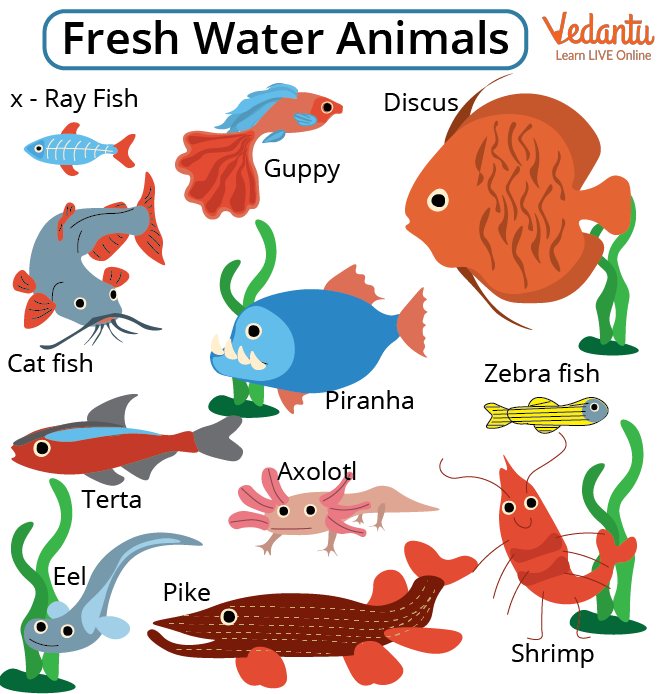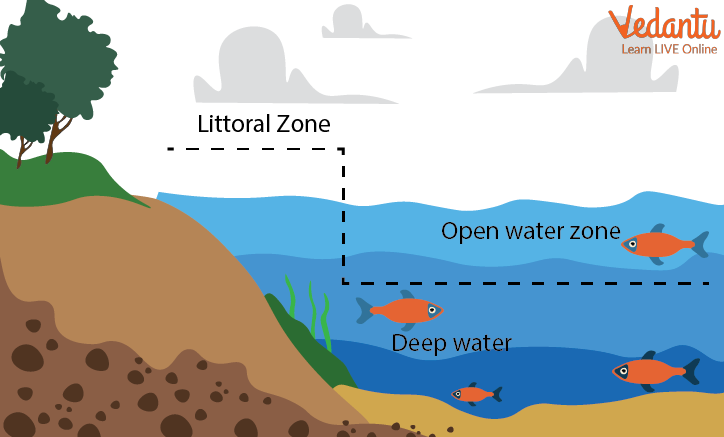




Quick Guide: Fish, Amphibians, and Invertebrates in Freshwater
The marine and freshwater biomes are the two main categories of aquatic ecosystems. The marine biome, saltwater like the ocean, is defined as having a high salt content, whereas the freshwater biome has a low salt content.
Around 70% of the Earth's surface is covered by water, but not all of it is fresh water. Freshwater makes up only 3.5 percent of the total, with oceans making up 96.5 percent.
Ponds, lakes, streams, frozen water, and other freshwater sources can be found in addition to oceans and seas. In terms of biodiversity, the freshwater ecosystem is crucial. When compared to the saltwater ecosystem, it is less extensive.

Freshwater Animals
Which Water is known as Freshwater?
Freshwater ecosystems include lakes, ponds, streams, rivers, marshes, which lack trees but have grasses and reeds, and swamps, which have woody plants and trees. (The rest is made of seawater.) More than 100,000 plant and animal species can be found in freshwater.

Formation of Freshwater
Several species surround freshwater fish. Unusual freshwater species include the river dolphin and diving bell spider. Algae, cattails, and willow trees, among others, use their root systems to filter pollution and extra nutrients from the water, assisting in maintaining clean water.
List of Animals Found in Freshwater
There are numerous species of insects, as well as alligators, beavers, otters, turtles, frogs, marsh birds, mollusks, snakes, and snails. Unusual freshwater animals include the river dolphin and the diving bell spider.
Formation of Freshwater Area
A variety of natural processes creates lakes. Between 12,000 and 1.8 million years ago, glaciers were moving across Earth during the last ice age, and many of them began to form. These glacial erratics left behind enormous hollows in the landscape that accumulated rainfall and runoff. Others were made when the Earth's crust moved, generating ridges and grooves that could collect water.
Additionally, all the magma may occasionally pour out when a volcano erupts. Land falling into an empty crater generates holes that have the potential to grow into enormous lakes. It is how Oregon's Crater Lake was created. When snow or ice melts, it cascades down mountains and follows the valleys and valley channels to the sea—rivers always flow to an ocean.
Wetlands, regions where the ground is mainly covered by water, frequently develop around rivers that flood or in areas where groundwater seeps up through the bedrock beneath the soil. Different rocks, including granite, sandstone, and limestone, make up bedrock. These rocks' fissures are open to water infiltration, which can disintegrate limestone. Beavers can build wetlands by damming rivers and streams.
Most Significant Freshwater on Earth
The Everglades, a 1.5 million-acre wetlands in southern Florida, is the world's largest freshwater habitat. The Amazon River in South America flows through six countries, including Peru and Ecuador, and runs 4,000 miles (6,400 km) to the Atlantic Ocean. Lake Baikal in Siberia, Russia, is the world's largest lake. Freshwater habitats are essential ecosystems for our planet, whether you're a hungry turtle, a pollutant-sucking plant, or a thirsty human who enjoys playing in the water!
Summary
We can conclude from the above article that freshwater creates a hypotonic environment for aquatic organisms. It is a problem for organisms with previous skins or gill membranes, as their cell membranes may burst if excess water is not excreted.
Some protists do this through contractile vacuoles, whereas freshwater fish do so through the kidney. During these migrations, they undergo hormonally controlled changes to adapt to the changing salinity environments. The eel uses the hormone prolactin, whereas the hormone cortisol is essential in this process in salmon.
FAQs on Freshwater Animal Names: Essential Species Every Student Should Know
1. What defines a body of water as 'freshwater'?
A body of water is defined as 'freshwater' when it has a very low concentration of dissolved salts, typically less than 0.5 parts per thousand. This includes water found in rivers, lakes, ponds, streams, and wetlands. Unlike the ocean, which is saltwater, freshwater is essential for the survival of a unique range of plants and animals adapted to these low-salinity conditions.
2. Can you name 10 common freshwater animals found in rivers and lakes?
Certainly! Here are 10 common freshwater animals that students often learn about:
- Trout (Fish)
- Frog (Amphibian)
- Beaver (Mammal)
- River Otter (Mammal)
- Snapping Turtle (Reptile)
- Crayfish (Crustacean)
- Dragonfly Nymph (Insect)
- Freshwater Snail (Mollusc)
- Catfish (Fish)
- Kingfisher (Bird that hunts in freshwater)
3. What are the major groups of animals that live in freshwater environments?
Freshwater environments support a diverse range of animal life, which can be grouped into several major categories. These include:
- Fish: The most abundant group, including species like bass, trout, and carp.
- Amphibians: Animals like frogs, toads, and salamanders that spend part of their life in water.
- Reptiles: Such as turtles, snakes, and crocodiles that inhabit freshwater areas.
- Mammals: Including river dolphins, beavers, and otters.
- Invertebrates: A vast group comprising insects (like mayflies), crustaceans (like shrimp and crayfish), molluscs (like snails and mussels), and worms.
4. How are freshwater animals adapted to survive in low-salinity water?
Freshwater animals have developed remarkable adaptations to thrive in low-salt environments. Their primary challenge is to prevent their body cells from absorbing too much water and losing essential salts. They manage this through:
- Specialised Gills and Skin: Fish gills actively absorb salts from the water into their blood. The skin of many freshwater animals is less permeable to water than that of their saltwater relatives.
- Efficient Kidneys: They produce large amounts of very dilute urine to expel excess water while retaining vital body salts.
- Respiratory Systems: To breathe, fish use gills to extract dissolved oxygen directly from the water, while mammals like otters must surface to breathe air with their lungs.
5. What is the main difference between freshwater and saltwater animals?
The primary difference lies in how they manage water and salt balance, a process called osmoregulation.
- Freshwater Animals: Their bodies are saltier than the surrounding water. They constantly battle to keep water out and salts in. Their kidneys produce a lot of dilute urine to get rid of excess water.
- Saltwater Animals: The surrounding seawater is saltier than their bodies. They face the opposite problem: losing water to the environment. To compensate, they drink seawater and have specialised cells in their gills to excrete excess salt.
6. Why are amphibians like frogs and salamanders often found near freshwater bodies?
Amphibians like frogs and salamanders are intrinsically linked to freshwater for several critical reasons related to their life cycle:
- Reproduction: Most amphibians lay their eggs in water. These eggs are soft and lack a protective shell, so they would dry out on land.
- Larval Stage: The young, such as tadpoles, are fully aquatic. They have gills to breathe in water and live there until they undergo metamorphosis into their adult form.
- Moist Skin: Adult amphibians have permeable skin that must stay moist to help them breathe, a process called cutaneous respiration. Staying near water prevents their skin from drying out.
7. Besides fish and amphibians, what other kinds of animals live in freshwater?
Absolutely. While fish are the most well-known, freshwater habitats are teeming with other types of animals. Important groups include:
- Mammals: Animals like the Beaver, which builds dams, the playful Otter, and large herbivores like the Hippopotamus in Africa.
- Reptiles: Many turtles, water snakes, and crocodilians like the Alligator depend entirely on freshwater rivers and swamps.
- Birds: Species such as Ducks, Herons, and Kingfishers rely on freshwater bodies for food and nesting.
- Invertebrates: This is a massive group including freshwater crayfish, shrimps, snails, mussels, and the larvae of many insects like dragonflies and mosquitoes.















